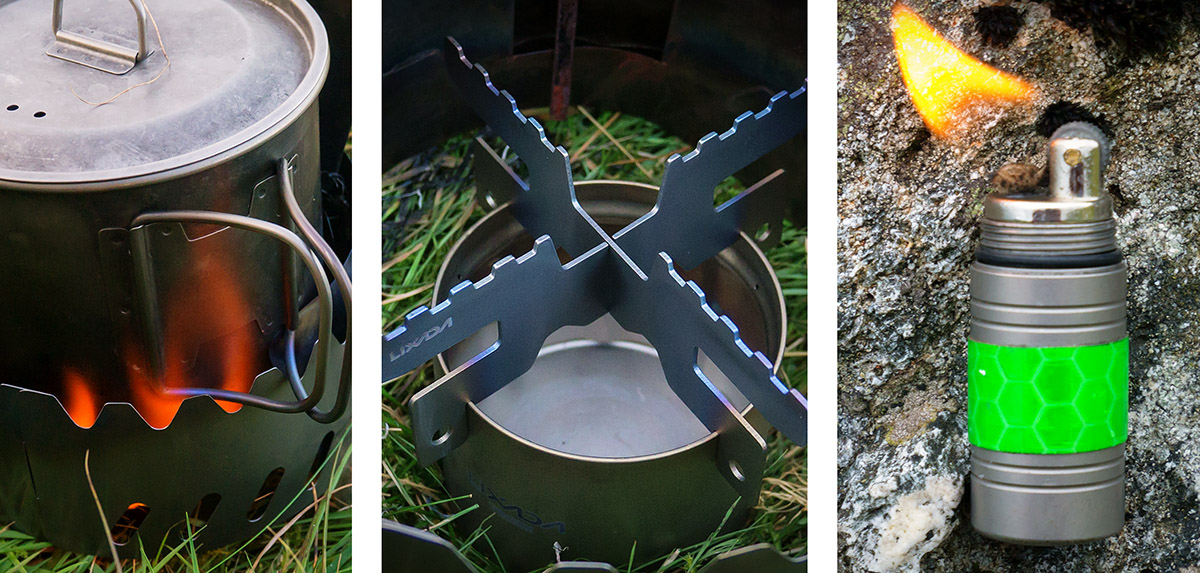A Repository For Miscellanea Around Stoves, Fire & Fuel
Preface
We were going to do individual mini-reviews for a number of the items that will appear in this post, but rather than eulogise a titanium fuel capsule or expound the virtues of a peanut petrol lighter for sub-zero conditions, we thought we'd have a single post for all such miscellany. So here it is, our "Notes on Flame & Fuel".
Test item(s): Various
Kit Tests: Winter, Summer
Disclaimer: None required (items not provided by manufacturers)
Summary Datasheet: Measured Weights, Prices (RRP), Links
| 1. Lixada Mini Alcohol (Siphon) Stove + Cross Stand * | 45g + 18g | ~ £20.00 | Google Search |
| 2. TiTech Titanium Peanut Lighter Stonewash | 24g | £18.95 | Trusted UK Retailer |
| 3. TiTech Titanium Capsule (4.5 x 1.5) / with fuel | 10g / 16g | £10.95 | Trusted UK Retailer |
* Since Amazon is increasingly acting as China's retail aircraft carrier in the west, we recommend bypassing Amazon and buying direct from AliExpress where you'll likely get a better deal (but also endure a longer wait). Quoted approximate (shop around) price includes shipping and taxes.
Scramble Review
Contents
- Introduction
- An Ultralight Siphon Stove (for short duration treks < 5 days)
- A Sub Zero Petrol Lighter (and the issue of evaporation)
Introduction
At Scramble we've used and tested pretty much every kind of stove and fuel out there. In terms of alcohol stoves I'd never got on with the Trangia type stoves (original or the titanium spin-offs). We're very much wedded to the remote gas canister stove and for long distance trekking have seen no reason to alter this view, but for shorter treks I felt there had to be a genuine and perhaps lighter alternative. So we revisited a range of gel and liquid-based lightweight mini stoves and ran some tests and the one that performed the best I decided to take on the 2023 summer kit test (as a backup). Carrying less than my normal gas supply, I'd use the mini-stove to supplement the shortfall.
The one we decided to go with was a titanium siphon stove by Lixada (or at least branded as such). There's an elegant simplicity to these stoves that I do find appealing and not a lot that can go wrong. There are a couple of caveats:
- There are compromises that have to be made to keep the weight to a minimum.
- These are great little stoves for short duration treks but when you're out for 5 days or more, gas is surely the way to go.
Later we're going to have a look at some lighters (and whatever else gets added to this post) but first let's have a look at some CHS tech.
An Ultralight Siphon: The Lixada Mini Alcohol Stove
The Siphon
The Lixada Mini Alcohol Stove is a Capillary Hoop Stove (CHS), otherwise known as a siphon stove. The liquid fuel is drawn up via capillary action through a thin double-wall to the stove's rim where it accumulates and vaporises forming jets from small holes in the stove's rim.
There are forums full of ridiculous claims bragging about "how few millilitres of fuel I needed to boils two cups (whatever that measure means) of water" without stating the starting temperature of the water, the elevation, the ambient air temperature, the wind speed, the specific fuel used and on and on. However, what is generally agreed upon, is that the siphon stove strikes a good balance between fuel efficiency and heat generation (i.e. boil time).
I took some extra stuff with me to compliment the Spider windshield I already had, and so the kit test setup was as follows (we'll talk about a more ideal setup later):
- 250ml aluminium fuel bottle (40g empty) with a 35ml titanium measuring cup lid (a 10g extravagance) and 180ml of bio-ethanol (~140g)
- a four-piece titanium (crown-like) stand that I thought I might want (more on this below), which I used to house the titanium windshield I already had with me
- the siphon stove and cross stand (45 + 18g = 63g)
 The Lixada Siphon supplementing the Kovea Spider setup
The Lixada Siphon supplementing the Kovea Spider setup
Dimensions
The Lixada siphon stove is a little bigger than some on the market with a maximum fuel capacity of 60ml and because I'm not just boiling "cups" or 500mls of water (which seems to be everyone's testing standard) I wanted a more generous capacity. It's 60mm in diameter and 50mm tall - with its cross-stand it's 78mm tall.
 The Lixada Mini Alcohol Stove takes up little space but has a large fuel capacity for an alcohol stove.
The Lixada Mini Alcohol Stove takes up little space but has a large fuel capacity for an alcohol stove.
Fuel Bottle
For flammable liquids, something that won't leak or puncture is pretty sensible, so I carried my bio-ethanol in this 250ml aluminium bottle from The Bottle Warehouse. The 35ml titanium Lixada (measuring) cup / lid fits nicely on the top and the bottle's base fits inside the stove.
 This 250ml aluminium bottle fits nicely inside the stove and is capped with a 35ml titanium measuring cup.
This 250ml aluminium bottle fits nicely inside the stove and is capped with a 35ml titanium measuring cup.
Performance
How these stoves perform is very much a function of conditions. If it's warm and you're out of the wind you're going to need less fuel. I'd budgeted for 35ml to boil around 850ml of water. First time around, I could have used less, later I needed more.
Pictured below was the first use of the siphon and the boil-time with 35ml of fuel was surprisingly rapid. I was actually caught off guard as it seemed faster than my Kovea Spider stove (though I don't thrash the Spider but rather use it with fuel efficiency in mind, of course with these stoves there's just one setting: burn baby, burn !):
 Boiling 850ml of water with 35ml of fuel in very quick time (with some fuel left-over).
Boiling 850ml of water with 35ml of fuel in very quick time (with some fuel left-over).
Fuel Budget
If this stove was all I was taking on a 4 day trek, where I had nuts for breakfast, cold smoked meats and flapjacks mid-trek and a large hot meal and a cup of tea at the end of each day, I'd take 250ml of fuel (= 197g of bio-ethanol) and budget for 50ml to do an approximate 900ml boil regardless of conditions. I'd rather have a surplus than a deficit and it's nice to grab an extra cuppa or two to treat oneself.
Ideal Setup: Current Kit
The 4-piece titanium stand / windshield (they actually come in 3 pieces, but are cheap so I bought 2 and used 4 pieces to get the right circumference) wasn't really necessary. I used this purely because I wanted to use my titanium Spider Windshield.
I now use a simple 300mm x 100mm 0.1mm titanium "foil" sheet (which weighs 13g) as my windshield (mock-up in the green box pictured below). This is left tightly wrapped so it's spring-loaded prior to being wrapped around the bottle. When released it hugs the 900ml titanium pot leaving a gap for the handles and this allows sufficient air-flow to feed the stove.
 Switched out an unnecessary accessory with something a bit lighter.
Switched out an unnecessary accessory with something a bit lighter.
The total weight of this setup is 126g:
- 50g - 250ml aluminium bottle + titanium 35ml cup
- 63g - siphon stove + cross stand
- 13g - titanium sheet sprung windshield
Add a very generous 250ml helping of bio-ethanol fuel for 4 days / nights at 197g. The total comes to 323g. And that works for all seasons and temperatures.
Compared to gas
In contrast a 100g gas canister (173g) + a titanium canister-top stove (~50g) + a clip on aluminium windshield (perhaps the most popular is the Optimus at 80g) = 303g. Now, you could probably do better than the Optimus windshield but you're still in the vicinity of the siphon stove setup. The major issue here is that the canister-top stove simply won't work that well in sub-zero temperatures. In addition, the more one uses alcohol stoves, the more skilled and accurate you get at dialing in your true fuel needs. This will reduce the weight further and it's easier to adjust your liquid fuel requirements than those of compressed gas.
To be clear, we're not saying this is the only way to go for short treks, but rather that the siphon stove is a genuinely viable alternative to gas on shorter duration treks and something worth considering.
Negatives
One negative that should be stressed is stability. Personally, I didn't have much of a problem, but a 60mm base means the user needs to play around a bit to find the right spot to ensure everything is stable.
Once your water has boiled (and this is really just a stove to boil water, it's not for any master-chef exhibitionism) you need to remove the red hot cross-stand to snuff out the flame. It can be done, but you need the right tools or gloves in your kit-bag. Once removed, the fuel can be poured back into your bottle. Some stoves have screw tops which act as snuff lids, but one of the things I like about the siphon stove is that it doesn't have a lid, so a bottle can slip inside it. Swings and roundabouts.
A Sub Zero Petrol Lighter: TiTech Titanium Peanut Lighter & Fuel Capsule
Introduction: Cold Hands! Hot Bodies!
During intense activity in cold and sub-zero conditions there are a number of systems operating at different temperatures; hot bodies in cold environments. The temperature outside may fluctuate, but a person's core body temperature is a highly thermo-regulated system constantly attempting to establish equilibrium:
An unclothed person can be exposed to temperatures as low as 12.8 °C (55 °F) or as high as 54.4 °C (130 °F) in dry air and still maintain almost constant core temperature. (source: NIH - Physiology, Thermal Regulation)
Then we have what's going on between these two systems; the proximate surface temperature of a suitably clothed person working their arse off in the cold.
Running On Empty
The reason for this pre-amble is the evaporation of petroleum-based lighter fuel:
Keeping a Zippo full of fuel, however, is a challenge. Zippos burn a lighter fluid made up of a petroleum distillate or synthetic isoparaffinic hydrocarbon known as naphtha. This substance evaporates at temperatures of around 21°C (70°F), quickly rendering your lighter empty and ineffectual.
The theory goes that in terms of fuel evaporation, Zippos should be okay in sub-zero temperatures, but this has not been our experience and we've tried bands to seal the lid, zip-lock bags and nothing has prevented the evaporation of this pesky fuel. I think the reason for this is stated above; Zippos may be fine when left out in the cold, but when they're in that space between their owner's core and the outside air, the user's proximate surface temperature is sufficient to cause petroleum distillate to evaporate.
When we assess outdoor kit, we're always looking for items that will out-perform the demands placed upon them. For example, kit tests are just 14 days (of self-sufficient trekking with no cheating) but we want gear that would work if they lasted 14 weeks. So we don't want a lighter that's going to be empty just when it's most needed.
We regard the lighter (like the knife) as part of ones essential emergency kit. I'm no survivalist or Ray Mears, but I am capable enough (and have had occasions involving thin ice where I've had to be) to make a fire in wet and cold conditions. So, whether you need to heat a knife for some minor surgery, seal some cord or just light your stove, having a decent lighter is helpful.
A Sub-Zero Lighter
As I'm sure readers of Scramble know:
fuels vaporise at different temperatures: Butane above -0.5°C; Isobutane above -11.6°C; Propane above -41.7°C. So, if it's below -0.5°C, liquid Butane will be left in the canister
For this reason Butane is a great lighter fuel in warm conditions, but rubbish when it's freezing. For all-season treks in the UK I carry both the lighters featured below.
Let's look at TiTech's solution to the Zippo problem first; solving the evaporation problem and making this a suitable lighter for very long duration treks.
TiTech Titanium Peanut Lighter & Fuel Capsule
The "peanut" lighter is similar to a Zippo in that it's a flint-spark-wick affair. Where it differs is that rather than an iconic flip-top lid, the peanut lighter has a screw-top and importantly comes with an o-ring seal. This solves the evaporation issue at the cost of some wind protection and ease of access. It's more trouble to unscrew a top than flip a lid.
TiTech's implementation, as their name suggests, is made from Titanium and helps keep the weight to a minimum.
 TiTech's titanium peanut lighter and fuel capsule.
TiTech's titanium peanut lighter and fuel capsule.
TiTech also make a number of small titanium capsules (we recommend the 4.5cm version pictured above). These also come with o-ring seals and will carry enough fuel for at least a couple of re-fills.
The combined weight of a fueled TiTech Peanunt lighter and a filled TiTech titanium capsule is less than an empty Classic Brushed Chrome Zippo (54g). In terms of cost, the TiTech-Zippo premium is £2.00; the two TiTech items will set you back (as of November 2023) £29.90 versus the standard Zippo which retails for £27.90.
A Jet Lighter
There are many butane jet lighters on the market and if you've found one you're happy with, there will be no reason to read on. We're somewhat agnostic about this, but just since we're on the topic, the lighter we use (and have been using in our manufacturing for sealing cord and fabrics etc) has been a very reliable, cheap and cheerful performer: The Maxi Jet lighter by Zenga (eBay search) and if you shop sensibly, you should be able to pick these up for under £3.00 each.
 The rubberised Zenga Maxi Jet butane lighter in blue.
The rubberised Zenga Maxi Jet butane lighter in blue.
It has a decent capacity and provides a mildly variable single jet and doesn't waste fuel pretending to be a blow torch. It has a slightly rubberised texture which makes it quite grippy and the (blue version) doesn't blend in with rock or undergrowth (which is the reason for the reflective green strip on my peanut lighter pictured below).
Here's the Scramble lighter set that is a mainstay of the fire / cook / survival kit and has been for around the last 3 years or so.
 A lighter combo for all seasons.
A lighter combo for all seasons.
That's all for now. If we have any additional minor items on the theme of flame and fuel, we'll update this post (and if updated it will be re-submitted so it appears as a new posting).
Product Images
Last Updated: 18/11/23












